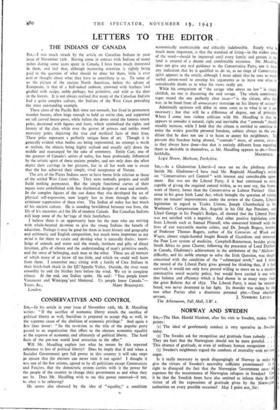THE INDIANS OF CANADA
LETTERS TO THE EDITOR.
SIR,—I was much struck by the article on Canadian Indians in your issue of November 12th. Having come in contact with Indians of many tribes during some years spent in Canada, I have been much interested In them, and feel that, although increasing attention is rightly being paid to the question of what should be done for them, little is ever said or thought about what they have to contribute to us. To some of us the picture of the ancient North American, before the advent of Europeans, is that of a half-naked redman, crowned with feathers and girdled with scalps, noble perhaps, but primitive, and wild as the deer, in the forests. It is not always realised that many of the Canadian Indians had a quite complex culture, the Indians of the West Coast providing the most outstanding example.
These clans of the Pacific Belt were not nomads, but lived in permanent wooden houses, often large enough to hold an entire clan, and supported on tall carved house-posts, while before the doors stood the fammis totem poles, decorated with figures and faces, which symbolised the rights and history of the clan, while over the graves of princes and nobles stood mortuary poles, depicting the true and mythical facts of their lives. These poles represent a perfectly unique form of art. Though it is generally evident what bodies are being represented, no attempt is made at realism, the objects being highly stylised and usually split down the middle and rearranged for the sake of symmetry. Emily Carr, one of the greatest of Canada's artists of today, has been profoundly influenced by the artistic spirit of these ancient peoples, and not only does she often depict their carvings in her pictures, but in all her work one is aware that she has achieved their simple, vivid acceptance of Nature.
The arts of the Plains Indians seem to have borne little relation to those . of the settled West Coast tribes. They were nomadic peoples and could build nothing permanent. But the simple functional curves of their tepees were embellished with fine rhythmical designs of men and animals. In the complex figures of the sun dance they also developed the art of physical self-expression, now largely lost to them through the indis- criminate suppression of these rites. The Indian of today has lost much of his ancient culture. He is standing bewildered between two lives, the life of lf s ancestors ani the life of modern Canada. But Canadian Indians still keep some of the her.tage of their forefathers.
I believe there is an opportunity here for the men who are striving with whole-hearted devotion to give the young Indians the benefit of education. Perhaps it may be good for them to learn history and geography and arithmetic and English composition, but much more important to my mind is for them to retain and develop what is naturally theirs: know-
ledge of animals and water and the woods, instincts and gifts of direct intuition, gifts of silence and the understanding of man's primitive needs, and the sense of belonging, each man to the other. These are all matters of which many of us know all too little, and which we could well learn from them. I remember onc, . sitting with a family of Cree Indians in their birch-bark shack in the QU'Appelle Valley. Outside, the river went smoothly by and the birches bent before the wind. We sat in complete silence. At the end, one Indian spoke. He said : "You people know Vancouver and Winnipeg and Montreal. Us people know Canada."—


























 Previous page
Previous page